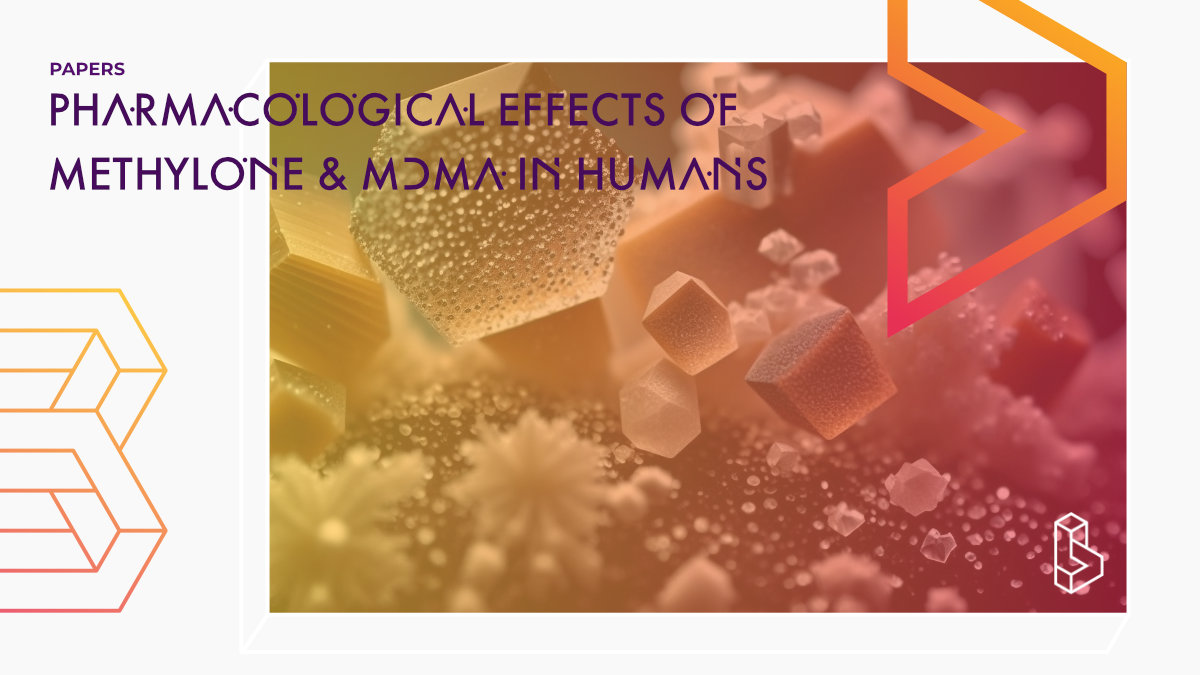This double-blind study (n=17) compared the pharmacological effects of methylone (200mg) and MDMA (100mg), for which methylone is a popular substitute. The results showed that methylone could significantly increase blood pressure and heart rate and induce pleasurable effects similar to MDMA, including stimulation, euphoria, well-being, enhanced empathy, and altered perception.
Abstract of Pharmacological effects of methylone and MDMA in humans
“Methylone is one of the most common synthetic cathinones popularized as a substitute for 3,4-methylenedioxymethamphetamine (MDMA, midomafetamine) owing to its similar effects among users. Both psychostimulants exhibit similar chemistry (i.e., methylone is a β-keto analog of MDMA) and mechanisms of action. Currently, the pharmacology of methylone remains scarcely explored in humans. Herein, we aimed to evaluate the acute pharmacological effects of methylone and its abuse potential in humans when compared with that of MDMA following oral administration under controlled conditions. Seventeen participants of both sexes (14 males, 3 females) with a previous history of psychostimulant use completed a randomized, double-blind, placebo-controlled, crossover clinical trial. Participants received a single oral dose of 200 mg of methylone, 100 mg of MDMA, and a placebo. The variables included physiological effects (blood pressure, heart rate, oral temperature, pupil diameter), subjective effects using visual analog scales (VAS), the short form of the Addiction Research Center Inventory (ARCI), the Evaluation of Subjective Effects of Substances with Abuse Potential questionnaire (VESSPA-SSE), and the Sensitivity to Drug Reinforcement Questionnaire (SDRQ), and psychomotor performance (Maddox wing, psychomotor vigilance task). We observed that methylone could significantly increase blood pressure and heart rate and induce pleasurable effects, such as stimulation, euphoria, wellbeing, enhanced empathy, and altered perception. Methylone exhibited an effect profile similar to MDMA, with a faster overall onset and earlier disappearance of subjective effects. These results suggest that abuse potential of methylone is comparable to that of MDMA in humans.”
Authors: Lourdes Poyatos, Clara Pérez-Mañá, Olga Hladun, Melani Núñez-Montero, Georgina de la Rosa, Soraya Martín, Ana M. Barriocanal, Lydia Carabias, Benjamin Kelmendi, Omayema Taoussi, Francesco P. Busardò, Francina Fonseca, Marta Torrens, Simona Pichini, Magí Farré & Esther Papaseit
Summary of Pharmacological effects of methylone and MDMA in humans
Methylone, also known as MDMC, k-MDMA, or M1, is a synthetic cathinone that emerged in 2004 as a new psychoactive substance (NPS). It has been popularized as an alternative to MDMA.
Methylone is a substrate for the high-affinity monoamine transporters, such as the dopamine transporter, norepinephrine transporter, and serotonin (5-HT) transporter. It increases extracellular concentrations of dopamine, norepinephrine, and 5-HT, which contributes to the rewarding properties of methylone.
Methylone was one of the most commonly used synthetic cathinones from 2011 to 2015, and has been detected in different matrixes such as oral fluid, wastewater, urine, hair, and nails.
Find this paper
Pharmacological effects of methylone and MDMA in humans
https://doi.org/10.3389/fphar.2023.1122861
Open Access | Google Scholar | Backup | 🕊
Cite this paper (APA)
Poyatos, L., Pérez-Mañá, C., Hladun, O., Núñez-Montero, M., de la Rosa, G., Martín, S., ... & Papaseit, E. (2023). Pharmacological effects of methylone and MDMA in humans. Frontiers in Pharmacology, 14, 328.
Institutes
Institutes associated with this publication
Germans Trias i Pujol University HospitalThe Institute for Health Science Research Germans Trias i Pujol (IGTP) is a leading biomedical research centre in Badalona, Barcalona, Spain.
Compound Details
The psychedelics given at which dose and how many times
MDMA 200 mg | 1xLinked Research Papers
Notable research papers that build on or are influenced by this paper
Methylone and MDMA Pharmacokinetics Following Controlled Administration in HumansThis double-blind placebo-controlled trial (n=12) assessed the pharmacokinetics (movement of drugs in the body) of varying doses of methylone (50-200mg) and MDMA in healthy volunteers. Plasma concentrations of methylone increased dose-dependent and quickly reached peak concentration levels. The method used here offers a fast and effective way to assess the kinetics of methylone, MDMA and their metabolites.
Methylone, a rapid acting entactogen with robust anxiolytic and antidepressant-like activity
This rat study finds that methylone (5-3-mg/kg) showed a reduction of 95% in immobility in the forced swim test (FST), a measure of antidepressant effects commonly used in mice studies. Methylone is similar to MDMA but shows less activity in the serotonin system. Pretreatment with an antidepressant (fluoxetine) didn't change the effects, indicating they may be co-administrated.
Linked Clinical Trial
Abuse Potential and Human Pharmacology of MethyloneThis trial (n=17) aimed to assess the abuse potential, subjective and physiological effects, pharmacokinetic parameters, and metabolism of methylone (200mg), a synthetic cathinone popularized as an alternative to illegal psychostimulants such as MDMA (100mg) and mephedrone.

